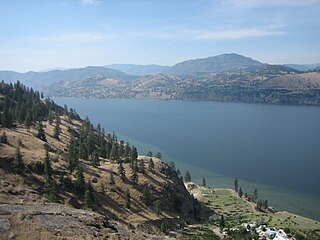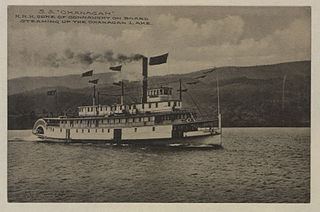
Okanagan Lake is a lake in the Okanagan Valley of British Columbia, Canada. The lake is 135 km (84 mi) long, between 4 and 5 km wide, and has a surface area of 348 km2.

The Okanagan, also called the Okanagan Valley and sometimes the Okanagan Country, is a region in the Canadian province of British Columbia defined by the basin of Okanagan Lake and the Canadian portion of the Okanagan River. It is part of the Okanagan Country, extending into the United States as Okanogan County in north-central Washington. According to the 2016 Canadian census, the region's population is 362,258. The largest populated cities are Kelowna, Penticton, Vernon, and West Kelowna.

Westbank is one of the communities within the City of West Kelowna in the province of British Columbia. It is 12 km to the west of Kelowna. Other communities in West Kelowna include Casa Loma, West Kelowna Estates, Shannon Lake, Smith Creek, Glenrosa, Rose Valley and Lakeview Heights. Westbank sits to the south of West Kelowna.
Okanagan-Westside was a provincial electoral district for the Legislative Assembly of British Columbia, Canada from 2001 to 2009.

Skaha Lake is a freshwater lake, through which the Okanagan River flows, in the Okanagan region of south central British Columbia. Along the shoreline are Penticton (north), Kaleden (west), and Okanagan Falls (south).

SS Sicamous is a large four decked sternwheeler commissioned by the Canadian Pacific Railway (CPR) and built by the Western Dry Dock and Shipbuilding Company for Okanagan Lake service between the fruit communities of Penticton, and other towns of Kelowna and Vernon, British Columbia. The vessel launched in 1914 and operated until 1937, and it is currently beached as a part of a heritage park cared for by the S.S. Sicamous Marine Heritage Society in Penticton. The vessel today is operated both as a museum, restoration site, and a facility for special events.
Okanagan Landing was an unincorporated settlement and steamboat port at the north end of Okanagan Lake in the Southern Interior of British Columbia. Located southwest of the city of Vernon, it was the terminus station for the Shuswap and Okanagan Railway and served as the port and shipyard for steamboats operating to the south, as well as a transfer barge slip.

SS Naramata is a steam tug commissioned by the Canadian Pacific Railway (CPR) company. She pushed barges and broke ice on Okanagan Lake from 1914 to 1967. After over 50 years of service, the boat was eventually retired and left to rest in Penticton beside her sister ship, SS Sicamous. In 2001, she was purchased by the S.S. Sicamous Restoration Society and is currently undergoing extensive renovations. Naramata is the only interior steam tug to be preserved in the province of British Columbia, Canada.

SS Okanagan was a steamship owned and operated by the Canadian Pacific Railway Lake and River Service. The vessel was constructed in 1906 at Okanagan Landing and launched in 1907, becoming Okanagan Lake's second steamship. She linked the transportation hubs at both the north and south ends of Okanagan Lake (Vernon and Penticton, respectively, aiding the development of interior British Columbia with other steamships of the 1900s. The ship was retired in 1934 and sold for scrap and spare parts. Only the Stern Saloon, a room in the back of the upper deck, remains. It was moved to the SS Sicamous Heritage Park in Penticton in 2002, to undergo restoration work.

SS York was a small steamer that was used to haul freight on Okanagan Lake and Skaha Lake. York was built in 1902 by Bertram Iron Works of Toronto and assembled at Okanagan Landing. She was pre-fabricated with a steel hull and was twin-screw-driven. She was a small vessel in comparison to the many other ships on the lake; York was only 88 by 16 feet. York was capable of moving 134 tons in freight and could carry up to 90 passengers.

SS Aberdeen was a steamship commissioned by Canadian Pacific Railway company. It was the first CPR steamship on Okanagan Lake and carried passengers and cargo from Okanagan Landing to Penticton from 1893 to 1919. Aberdeen connected communities along Okanagan Lake for the first time, creating a new era in the Okanagan Valley and greatly aiding the economy and settlement of the interior of British Columbia.
The Okanagan Regional Library (ORL) system serves the Okanagan region of the Canadian province of British Columbia. Its administrative headquarters are in Kelowna. The system covers 59,000 square kilometers of area, and serves 360,000 people through 30 branches. ORL was founded in 1936. In 2013, the library held 3.2 million physical items. The library is largely funded through tax revenues from four administrative areas, the Regional District of North Okanagan, the Regional District of Central Okanagan, the Columbia-Shuswap Regional District, and the Regional District of Okanagan Similkameen. It also receives funding from the provincial and federal governments.
The Penticton Aquatic Club was a boathouse, social centre, and clubhouse for aquatic activities in Penticton, British Columbia. Built in 1913 at the foot of Winnipeg Street by Okanagan Lake, it became an important part of Penticton summer life. It was perhaps best known for its annual Aquatic Regatta Day, which featured a variety of activities including a war canoe race. The building was demolished in 1952. The Club's four war canoes are undergoing restoration: one of them is a display at the S.S. Sicamous Heritage Park.
MV Okanagan was a tugboat that operated on Okanagan Lake, Penticton, British Columbia, from 1947 to 1972. It was the largest and last Canadian Pacific-operated tugboat on Okanagan Lake and its retirement marked the end of Canadian Pacific’s service on B.C.’s inland lakes and rivers, as well as 80 years of service on Okanagan Lake. During service, the Okanagan pushed railway barges up and down the lake and broke ice during winter.
MV Pentowna was a motor ship that transported passengers, and later freight, on Okanagan Lake from 1926 to 1973. It was the first boat to be owned and operated by Canadian National Railway (CNR) on Okanagan Lake and the first diesel-powered boat on the lake. Pentowna served the communities between Kelowna and Penticton with two daily round trips, aiding the development of the Okanagan Valley with its modern technology and speed.

SS Kootenay was a Canadian Pacific Railway (CPR) wooden-hulled sternwheeler that serviced the Arrow Lakes in British Columbia, Canada from 1897 to 1919. She was a large freight and passenger steamship and the first in a series of CPR riverboats built for the Arrow Lakes.
SS Columbia was a large screw-driven tugboat that operated on the Arrow Lakes and Columbia River in British Columbia, Canada.
Canadian National Tug no. 5, or CN Tug no. 5, was a tugboat owned and operated by the Canadian National Railway (CNR) company on Okanagan Lake in British Columbia, Canada. She was launched on May 8, 1930 and was a steel tug that pushed railway barges to the Okanagan Landing shipyard and railway connection to transport fruit. By the 1950s and 1960s, CNR had three tugs: MV Pentowna, CN Tug no. 6, and CN Tug no. 5. Only one tug operated at a time, though two would be used in busy times, and each tug only pushed one barge. CNR's competitor on the lake, the Canadian Pacific Railway company, ran three tugs at a time, as well as many sternwheelers over the years, and each tug pushed two barges. Although the date of CN Tug no. 5's retirement is unknown, CNR terminated barge service on the lake in 1973, retiring its last ship, CN Tug no. 6, due to the highways and other modes of transportation that had emerged by that time.
SS Maude-Moore was a wood-burning screw steamer that provided a ferry service between the communities of Summerland, Naramata, and Penticton on Okanagan Lake in British Columbia, Canada.










